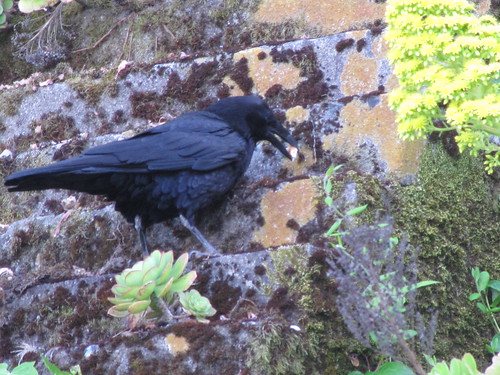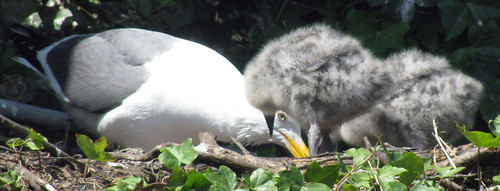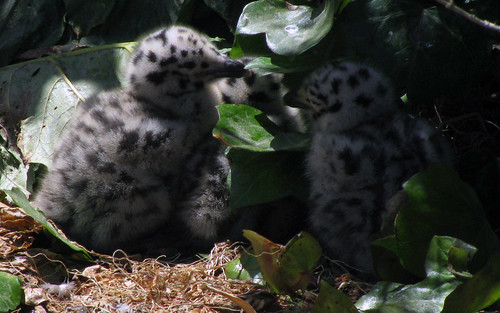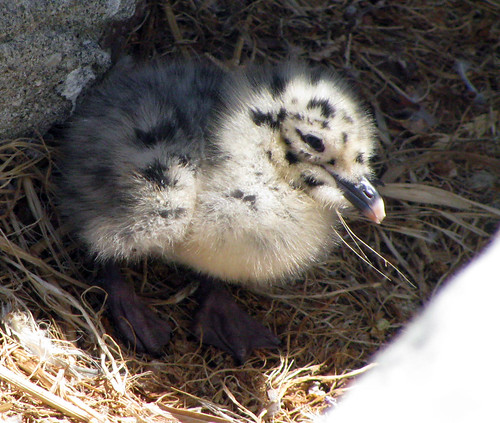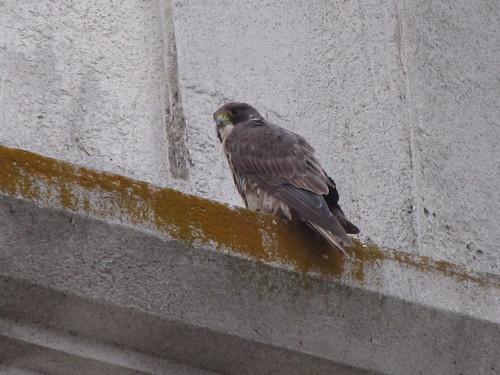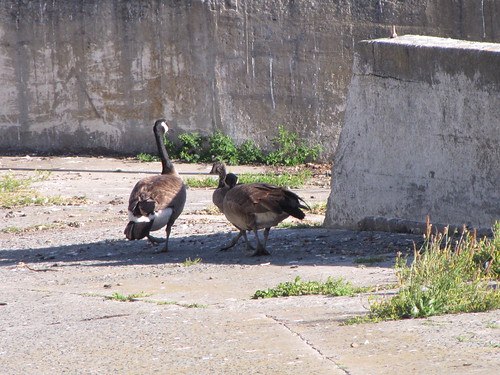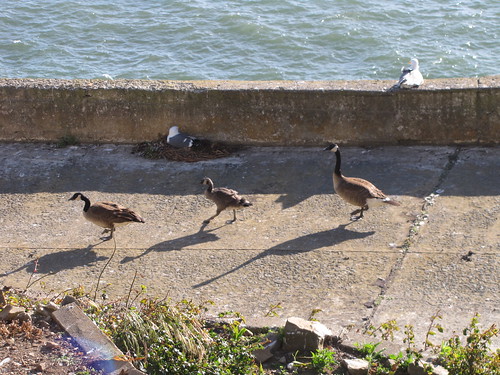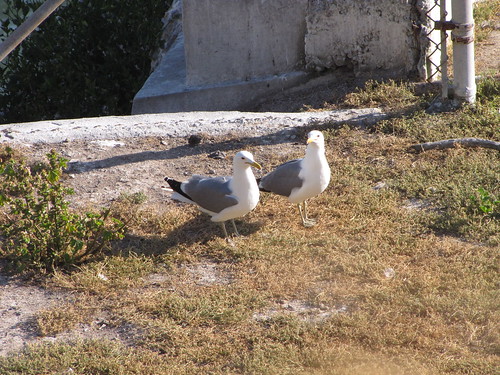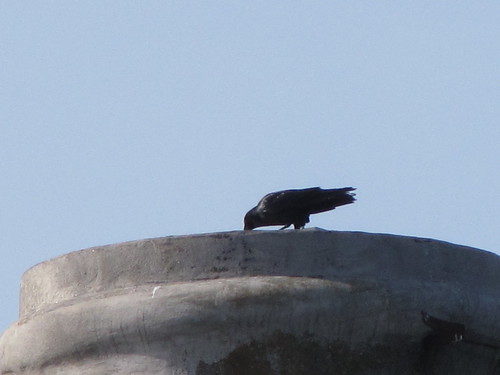Showing posts with label western gull. Show all posts
Showing posts with label western gull. Show all posts
Sunday, June 27, 2010
 Raven male defends his young; raven female is... where?
Raven male defends his young; raven female is... where?
1:08 AM | Posted by
Sweep Commander |
Edit Post

The ravens bred in 2010, but only one branchling left the nest alive. The adults watched over their young one closely and killed an adult western gull, apparently for showing a little too much interest in their pride and joy.
Then, suddenly, we went from three observable ravens to two. It seemed that the juvenile was gone. As new ravens will stay with their parents for a period of months, successful fledging and departure seemed unlikely. The speculation was of its possible demise.
As usual, the ravens had us fooled. The juvenile was still very much with us, and hiding right before our eyes. She or he vocalized softly and hoarsely while displaying submissive crouching and begging behavior typical of a juvenile or a subordinate individual in a larger group but unlikely behavior for for a breeding adult.
One mystery was solved. One of our visible ravens was the juvenile. The other was the male, discernible by its size and its trademark "fur pants" dominance display. So where is our breeding female? She's been unobserved for quite some time now.
I have a crazy hypothesis: she may be incubating a second clutch of eggs.
This would be more than unusual. It's almost unprecedented. Ravens are not double brooders, though given enough time, they will attempt another clutch if their first brood of chicks and eggs fails completely. Double brooding by ravens is so uncommon that it's only been documented in one single instance, during breeding season 2001, on the campus of UC Irvine.
My suggestion is just a hunch, but it has the following considerations in its favor:
First, there's time for a second brood. The ravens nested early this year. In the single documented case of double brooding, enough time and plentiful food resources were cited as possible factors enabling the behavior.
As for food, with a home territory like Alcatraz, with so much ecology and so much trash at hand, food wouldn't seem to be a problem.
Second, the natural resources arm of the Golden Gate National Recreation Area has visited the ravens' nest multiple times in 2010 and damage to the nest may have occurred. Just as the number of visible ravens dropped from three to two, they were observed carrying nest building materials to their tree, perhaps repairing damage their nest structures incurred. Bernd Heinrich, noted raven expert and author of the great book Mind of the Raven, observed that the ravens' cue to mate is not a ready female, but rather a finished nest.
Damaging the ravens' nesting structures may have inadvertently put them on a path towards a second clutch.
The third consideration is that while double brooding has never been documented except in the one paper I linked to, the paper's authors complain that not enough observations of this type have been attempted, especially on the divergent California clade, to which our ravens belong.
The surprising genetic differences between ravens of the American southwest and those found in all other contexts will be addressed in an upcoming post laying out what little we know about Alcatraz's raven pair.
The last consideration I'd offer in favor of the double brooding hypothesis is that Bernd Heinrich also says that if a raven minding a home territory loses its mate, he or she will find a replacement quickly, often within a day. That hasn't happened, though another plausible explanation for that might be that it's simply too late for courting and pair bonding this year, though I don't recall Heinrich indicating that this behavior is variable across the seasons.
This, combined with my gut feeling that the outright death of the female seems pretty unlikely, gives me the sense that our ravens are up to something once again.
This double brooding suggestion may be absolutely wrong and I realize that it sounds crazy. My hunches regarding birds are almost universally mistaken but if I'm right in this case, I'd like to be able to say I saw it coming.
Odds, ends:
The island loves to make a liar out of me. No sooner did I write a post entitled "A Coda on the Falcons of Alcatraz" than did the male peregrine decide to show himself on a consistent, daily basis. For now, the kid is back:
Now all he needs is a female companion to really give Alcatraz's ruling authoritarian corvidocracy a run for its money and I wouldn't miss it for the world.
Also as I disembarked onto the Alcatraz dock on Thursday, I was rendered speechless. I'd heard about ducklings on Alcatraz but neither BourbonHawk nor I had ever seen any. But there she was, a duck mother and her eight chicks, soon to be food for the predators that inhabit the island and the bay.
Sometimes words aren't good enough, so I slapped BourbonHawk on the arm and pointed them out to her, this late in the year and bobbing far too close to the machinery mounted to the rear of the boat we'd just disembarked from. We had a few jokes about these witless ducks being sucked up to their doom, but fortunately that didn't happen.
At any rate, I know they're gonners. My only hope is that they get taken by some novel predator like a seal, a porpoise or a sea lion. I'm getting a bit tired of all of this gull and raven brutality.
Here's your update on Ryan T. Gosling, the honking miracle. He's almost there. At this late date, it's a bit difficult to tell which one of the three he is, but I usually assume that the two proudest looking geese are his parents, and he's just the other one.
Brandt's cormorants! They're back indeed. Here's a picture from last year's disastrous lack of a nesting season:
And a picture from our last very good year, 2008:
And here's a picture from last week:
Progress is clearly being made and there are nests on the ground, but they may be dummy nests. These cormorants have built them multiple times now, only to fail to lay eggs and to retreat from them at any disturbance.
Still, the cormorants are having a resurgent year. They may not yet be successfully nesting on their old colonial grounds, but they're nesting less visibly on cliffs all around the island. I don't envy the wildlife biologists in their task to count them and measure their output in such treacherous places.
Lastly, I authored a post last night on a western gull predating a snowy egret chick. I know this post has been a long one, but check that one out too, especially if you don't mind a gruesome image to go along with it.
Wednesday, June 2, 2010
 Juvenile raven vanishes, breeding parents set to work on dastardly deeds, home repairs/additions
Juvenile raven vanishes, breeding parents set to work on dastardly deeds, home repairs/additions
7:11 PM | Posted by
Sweep Commander |
Edit Post
We last saw it on Sunday perched in a cypress tree eating an unknown food item. It had made an enemy of a California gull that buzzed it persistently to no effect. The most the gull could elicit from the fledgeling were a few low vocalizations.
The next day, it was gone, either fledged or dead. The bird flew well and it is now believed to have predated a western gull nest, so it appears to be more than capable of fending for itself. Also, though it was a bird in it's first year of life, it was significantly larger than the typical raven I observe on the mainland, just like mom and dad:
For size comparison's sake, the adult raven on the right and the human being on the left were equally distant from the camera as took this picture. Well... not really, but our ravens are still huge.
At any rate, though raven breeding season appears to be over, the pair is not taking a vacation. They have been actively collecting nesting materials in recent days and have been seen transporting them back to their home tree. I caught one collecting moss, presumably for nest lining.
Why would the ravens be working on their nest structures? Breeding season is over. Right?
Well, the nesting structures were examined earlier in the year by our park's biologists and portions of them were tampered with or disassembled in the process. The ravens may simply be rebuilding what was destroyed.
Also, nests must be repaired each year as the hatched chicks defecate inside the nest, but it's very, very early for that process to begin. Nest construction and repair usually occurs in the spring.
A more alarming conclusion might be that these birds are making preparations to lay a second clutch. It's hard to imagine that the moss lining they're collecting could keep from year to year and ravens will sometimes lay a second or even a third smaller clutch if the first one fails, but as far as we know the ravens did successfully fledge a single bird this year and it's awfully late in the season to lay new eggs.
We'll keep watching, however, because our giant and wily ravens are not to be underestimated.
Here's a video we took today of one of them eating a gull chick. As usual, sorry for the camera shake.
Monday, May 31, 2010
 Alcatraz has babies! Cuteness overload!
Alcatraz has babies! Cuteness overload!
11:51 PM | Posted by
Sweep Commander |
Edit Post
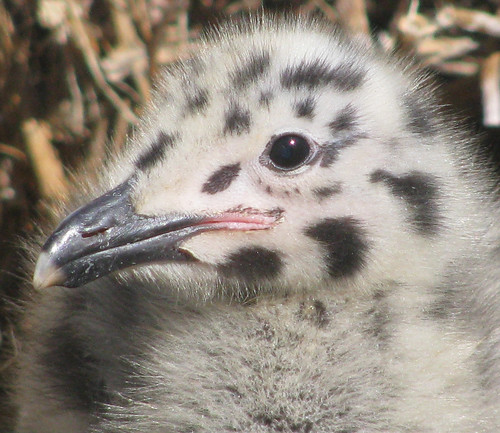
The visitor to Alcatraz wants his Al Capone, his "Machine Gun" Kelly and his "Birdman" Stroud. She wants to tour our rows of tiny cells, to see the narrow cots, the lead paint peeling off of crumbling walls and to hear the loud sounds of cell doors slamming, all behind a curtain of dense San Francisco fog. And we'll give them that.
But not before they find themselves surrounded by these speckled grey balls of pure fuzz and cuteness. Every year around this time, Alcatraz becomes an avian nursery nurturing around five percent of the world's baby WEGUs.
You'll be slain when confronted with three thousand of these. The following pictures are from summers past.
Nowhere else can you buy a ticket for a reasonable price, take a twelve minute ferry ride and experience this. Our baby WEGUs are beginning to hatch!
These were the first hatchlings we saw:
Pardon the graininess. This gull family lives deep in the parade ground area, which is closed for nesting season. As more chicks hatch, we'll have many more photos for you.
Unfortunately, it's our duty as a metal-themed bird blog to bring you br00tality as well. We don't enjoy doing it, but the bitter fact is that these balls of fluff often die at their cutest. One of the first clutches hatched yesterday and each chick promptly died. Amazingly, out of the thousand nests on the island, this was the one featured in our recent post entitled "Now we wait..." I wonder whether I've cursed this gull family. One individual:
But there is optimism to be had. Each nesting season we have our favorites that we root for and many of them go on to fledge successfully.
Speaking of babies...
Well, no one thinks of our fierce little peregrine tiercel as a baby but the little guy still hasn't donned his adult plumage. The books say we can expect him to turn from brown to blue after the breeding season. If he decides to stay and he survives through to winter, we'll have a better idea of where he falls among the three North American subspecies of the peregrine falcon. It's been suggested that he's a Peale's falcon, a coastal, northwestern variety that is the biggest and darkest of the three, and the largest subspecies of peregrine in the world. Our little guy may be a little small for all of that.
One concern with our peregrine is that while we still spot him regularly, the frequency of observation has declined considerably and now your only shot to observe him is to carefully scan the lighthouse. When his crop is full and he's feeling sedentary, he can be found on the upper ledges.
Ryan T. Gosling! Baby goose!
If there were an Intrade contract that Ryan would fledge, it would be trading at 95 cents for a dollar payout at this point. This guy/gal is money in the bank:
While we've been very critical of the geese that nest on Alcatraz, it's been a true privilege to watch this little guy at every stage of his development, from a cute but anonymous tiny ball of fuzzy green confetti, to a little yellow football-sized creature trying to make its way in the world. Now he's going on to be a real goose, quickly growing into his adult plumage. Where does the time go?
One more thing: Maganrord has one thing to say to the following pair of California gulls that has been seen near the old prison incinerator: Nest, or get off the spot! We're tired of seeing you hanging around doing nothing! We want to see some CAGU chicks.
Saturday, May 15, 2010
 the tales that odd plumage will tell you
the tales that odd plumage will tell you
12:42 PM | Posted by
Sweep Commander |
Edit Post
I'd been working on a few separate posts that in one way or another involved unexpected plumage and what you can know about a bird from an odd feather here or there. So, hell. It's one post now. Here we go.
This is a leucistic western gull that I met at Stow Lake in Golden Gate Park. Leucism is a condition which causes the afflicted to display unusually low levels of body pigmentation. It's similar to albinism, differing in ways I don't fully understand, but I do know that the presence of standard eye pigmentation is enough to establish that this guy is leucistic and not a true albino.
A google search revealed a report in the San Francisco Chronicle that an albino wegu hatched on Alcatraz in the summer of 1997. After I tracked down a former Alcatraz bird biologist, he informed me that the item was incorrect and that the hatchling in question was in fact leucistic! EUREKA!
With these birds quite often reaching fifteen years of age, it suddenly seemed possible that the leucistic gull of Golden Gate Park might have origins on Alcatraz.
Alas, the same bird biologist immediately informed me that the leucistic wegu disappeared while fledging, probably killed by a fellow gull or some other predator. Sometimes an investigation is dashed the moment it peeks your interest.
Still, we may be able to salvage an ounce of intrigue here. While this bird may not be a product of Alcatraz's gull colony, it may be the same as individual as this one, which visited Monterey over the winter of 2003/2004. The bird appears identical, and while that fact alone doesn't prove anything, this state of near complete leucism can't be all that common.
Other forms of aberrant plumage are far more common and a bit less intriguing:

In birder jargon, you'd say it lacks the typical mirrors on its outer primaries. In plain english, this gull's rear end, which is actually just the ends of its folded wings, lacks white spots. The following bird is a typically plumed wegu:


Sometimes odd plumage can indicate that the gull belongs to a different species entirely.

I captured this one flying over the island last winter. Superficially, it looks very similar to the gulls that make their home on Alcatraz.
But a closer examination reveals that unlike a western gull, this guy's head gets dark smudges during winter and it has grey -not black- wingtips. That's because this is a glaucous-winged gull, a close relative of our resident gulls, but a slightly larger, colder weather variant on the theme.
And what do we make of this bird?
We spotted this oddity nervously treading Alcatraz's parade ground over the winter. Unlike a western gull, it has a smudged head. Unlike a glaucous-winged gull, it has black wingtips.
It's a potential hybrid between the two.
Western gulls and glaucous-winged gulls hybridize freely along a stretch of coast extending from the border of Oregon and Washington up to the Canadian border. There, intermediate birds outnumber pure birds of either pedigree.
After observing many strange gulls over the winter with some visiting from as far north as the arctic, I've begun to wonder how gulls decide where to winter and where to establish themselves and breed.
Will birds be loyal to their winter haunts or could they spend one winter in Monterey and a few years later decide that Golden Gate Park is the place to be?
These are birds that take four years to develop their adult plumage and breed, meaning they have four years to explore. While there's apparently no truth to the rumors that this is part of the gulls' traditional variant on the Amish tradition of rumspringa, or that they spend this time backpacking in Europe, they may very well use these years to get a sense for preferred breeding and wintering grounds.
Lastly, when two gull species hybridize so extensively (and many others do as well) it poses serious problems for our general concept of a biological species. That's certainly the subject of a post to come.
Saturday, May 1, 2010
 Gull fights revisited
Gull fights revisited
12:50 PM | Posted by
Sweep Commander |
Edit Post
Let's get nerdy for a minute.
A while back we managed to record a 27 minute gull fight, which by one visitor's testimony, began with an argument over a morsel of chicken.
Whenever I witness such a pointless exercise, I wonder how the larger taxa of gulls could possibly have achieved unfathomable numbers and worldwide distribution when they are prone to costly fights with trivial causes. Why hasn't natural selection blessed them with calm breeding colonies where gulls treat each other with trust and deference, looking after one another, only turning their wrath on malicious intruders?
Evolutionary biologists sometimes refer to a very beneficial adaptation of form or behavior as a "neat trick".
My first thought was that the gull's basket of tricks is so collectively neat that the group can afford to loose a little blood at the margins, especially as the camber of a gull's wing was once described by Stephen Jay Gould as the nearest nature comes to perfection. Also, these guys eat trash, and we make tons of trash. That's the neatest of tricks.
But this explanation of gull on gull violence doesn't seem to work, at least at first. A species may tend to acquire traits that are maladaptive in one regard, e.g. cormorants becoming heavier and so losing their ability to fly proficiently, but it only adds up if in so doing they are improving themselves in another regard, e.g. cormorants becoming heavier and thus more proficient divers. The flightless cormorant has made an outright exchange of its flight capabilities for a body that is singularly adapted to life in the water.
You might think that a gull could hold onto all of its neat tricks of wing design, omnivorous diet and trash consuming opportunism while still being more socially amicable. But this hasn't materialized. What is going on?
The difference between the fitness of an individual and the fitness of a species may provide us with half of an explanation. If all gulls were friendly to their fellow colonists, this would undoubtedly be good for gulls collectively, but it wouldn't benefit individuals who have something to gain from harming their conspecific neighbors. After all, these are creatures who occasionally meet their dietary needs by killing and eating the young of their own species.
The Irish elk is familiar with the difference between collective and individual fitness, or at least it was before it fell into extinction around eight thousand years ago.
Success in the fight for mates is believed to have been partially determined by the size of an individual's antlers. As you might imagine, the antlers grew large and unwieldy. The devlopment of traits that were good for the individual were bad for the survival prospects of the species, possibly bringing it to the point of extinction. The narwhal may be undergoing a similar process if sexual selection is causing the size of their otherwise useless tusks to grow over generations.
Perhaps the popularity of these violent traits among gulls can be partially explained by understanding how they benefit the individual gull who displays them rather than all gulls at large. I'd imagine that arriving at a gull colony like Alcatraz is a little like arriving at a functioning prison in that the sage advice is to find a suitable target and pick a fight over something trivial. Win or lose, it will be known that you will defend yourself, your territorial boundaries, your hard won food, your eggs and your young. It would harm your prospects if other gulls recognized you as a bird which habitually engages in appeasement to avoid violence. My guess is that this is part of the answer.
For additional clues, we should think back to the case of the cormorant taxa and their tendency towards compromising their ability to fly in order to enhance their ability to dive. Although it seems like gulls aren't trading away their ability to socialize by making an analogous bargain, on reflection, I think that they are.
Gulls are vicious predators and they're wildly successful in that regard. They are well served by yet another neat trick that is easily obscured by their superficially unobtrusive and harmless presentation. This trick is their willingness to inflict harm at the drop of a shred of chicken, to aggressively fight over any edible trash, and to attack and kill any sick, injured or otherwise vulnerable animal. LadyBird, BourbonHawk and I saw a gang of gulls butcher and eat the cutest baby geese you'll ever see.
I can't know for sure, but I strongly suspect that the gull's abidingly malevolent orientation towards all other creatures, which serves it well in many respects, is guaranteed by hormones and brain structures that are too rigid to be switched off for interactions with their own kind and on again for perpetrating violence against victims of other species.
As a result, each of our western gulls appears to be out for itself. The bloody tendencies designed to serve its feeding strategies have generalized, giving shape to each bird's interactions with its fellow WEGUs. That, and the possibility that natural selection based upon individual and not collective fitness has given form to gull social behavior, may serve to explain the paradoxical observation of two gulls fighting for 27 minutes over a 40 calories of discarded chicken.
Also, I know this wasn't news, but it's been on my mind lately. News soon to come on goslings, ravens, gulls, snowy egrets, and the world famous Alcatraz peregrine tiercel.
Wednesday, March 24, 2010
 Tiercel still around, cryptic, gleefully terrorizing the WEGUs
Tiercel still around, cryptic, gleefully terrorizing the WEGUs
12:12 PM | Posted by
Sweep Commander |
Edit Post
Our tiercel has become very secretive, but when he is visible, he's having a great time.
He goes about life doing exactly what I might were I given an hour in a falcon's body. Our bird passes the time by messing with gulls in extravagant aerial combat.
We observed him doing so yesterday around 6 pm near the dock.
On a more boring note, I've finally begun to identify which subspecies of Canada goose are present on the island. So far, it's just the 'common' variety. Booooring. I have seen one pair of smaller geese on the island. I'm hoping to have pictures of those up soon, hopefully with an identification.
Sunday, March 14, 2010
 Falcon dines again (Also: Comments Fixed!)
Falcon dines again (Also: Comments Fixed!)
9:16 PM | Posted by
Sweep Commander |
Edit Post
Now to the meat of it.
She looks happy. As usual, there are more pictures of all sizes on my flickr.
Sorry for the graininess on these photos and videos. These photos were taken utilizing a ridiculous level of optical and digital zoom. I love my camera. It's not the $3,000 body and lens setup I dream of, but somehow this combination of 80x zoom and a tripod can yield somewhat intelligible images at great distances.
It's unknown what this prey item was. Several white feathers fell from the smokestack as she ate. Several of my final images of her eating show her standing on a white feather, presumably from her quarry.
Here are a few very short videos of her dining.
I guess it wouldn't be a proper MAGANRORD post without a falcon video with semi-humorous narration.
In the following video, she finishes up and departs.
I was truly struck by just how red the meal left her beak and talons.
Also, the white feathers invite a bit of curiosity. The only prey item available that yields consistently white feathers is a gull, and our gulls are probably a little too big for her. Pigeons can be lightly plumed, so that's possible, though every feather I saw was as white as snow so I'm a little bit skeptical of that possibility. Our snowy egrets haven't returned yet, so they're ruled out.
Peregrines do scavenge and dead gulls have been turning up on Alcatraz. There were two such departed on the roof of the new industries building this afternoon.
Whatever the prey was, the female filled her crop and there were leftovers:
If the female abandoned her bird without finishing it, it may have been a large bird, like a gull or it may reflect her assessment of available prey. Slim pickings will mean a thoroughly devoured corpse. Abundance means she eats her preferred parts and leaves leftovers for others to scavenge.
Who says corvids and falcons can't be friends?
Also, meet this guy:
I saw him duke it out with another WEGU in a half hour brawl over what a visitor who witnessed the madness said was just a morsel of food. The whole thing made me positively squeamish and I think it led to some rather shaky camera work as I recorded the encounter.
I'm going to post our 26 minute video in the coming days. I don't expect that anyone will watch it but I do want to make a point about the gull's way of life. It's awful. It's not all mating and gloriously forcing down huge starfish. It's a lot of senseless violence. Ounces of blood and a half hour of combat leaving both gulls exhausted seems like it isn't worth a bit of chicken, which is readily available to these gulls.
Stay tuned.
Friday, March 5, 2010
 Dead bird update
Dead bird update
12:18 PM | Posted by
Sweep Commander |
Edit Post
Update:
BourbonHawk: And here's a picture:
Wednesday, March 3, 2010
 Where did they go?
Where did they go?
5:58 PM | Posted by
Sweep Commander |
Edit Post
Where are our falcons?
I would very much like to see the peregrines establish themselves permanently on Alcatraz but recent observations leave me worried that any raptor pair making a home on a small island populated seasonally by two thousand western gulls faces an arduous task; I hope that our falcon pair hasn't failed already. More on that in a moment.
There is the aforementioned tendency of the gulls to take to the sky in alarm whenever the falcons soar over their roosts. In one such instance, I saw several gulls actually attacking one of the falcons in midair.
There is also a certain reckless aggression practiced by the pair and especially by the male. The ravens are certainly enemies of the gulls but they trespass on the gulls very selectively and very, very carefully. The ravens may harm the gulls by occasionally taking their eggs and young but they are deft enough to avoid being mobbed in large groups.
On the other hand, the male falcon thought that it might be wise to nearly take the head off the female raven as she was soaring by. Far from doing anything to provoke him, she seemed not to notice him until she suddenly dove to evade the attack.
On that same occasion (Monday, March 1st 3:45-4:45pm) I saw the female falcon on the railing of the water tower, stationary, apparently watching the male's antics. He would fly up, join her on her perch, hop around and then take to the sky for a few more laps of ill advised adventure.
As he aggressively darted in, around and through a cloud of angry gulls over the recreation yard and the new industries building on the west side of the island, the female only watched his maneuvers. After one energetic run, he failed to rejoin her. The gulls quieted down and their numbers in the air fell to just a few.
Ten minutes later, I spotted a dead bird on the roof of the new industries building. I reported it to our wildlife biologist and I'm at least 95% sure that it's a western gull but even with binoculars it's difficult to be sure. Tomorrow, I'll have the right hardware to make a final determination. Stay tuned.
Yesterday, in all of my outings, I saw only the female and only for a small part of the day. Today, we saw neither falcon. It's the first time in many weeks that I haven't seen either bird. They are so habit driven and preferential to the same few haunts (the water tower, the power plant, a couple of cypress trees) that it's worrisome not to have made a single sighting on any of our outings.
I know with only one falcon-free day that it's far too early to fret, but the recent conflicts with the gulls and the ravens have left me with the sad expectation that these birds won't succeed in establishing themselves. The gulls have become more numerous since the falcons arrived in November and they have become more assertive. I wouldn't be shocked if one of the falcons fell in a bloody adventure, or if they decided Alcatraz and its thousands of large gulls wasn't friendly to their reproductive prospects.
Here's to pleasant surprises of all kinds.
Odds, ends:
I got my camera back today. Expect visual media. Uh, lots.
I checked in on Lucky the WEGU today, and (s)he is alive and well, chasing adult gulls and begging for food, as is his/her pattern.
We observed a group of four crows on the island today, marauding around, soaring and executing a number of funny diving maneuvers. BourbonHawk can tell a crow from a raven at great distances and if she can't see the birds, she can tell from their calls. I, on the other hand, have some work to do.
That's it for today.
More soon.
Sunday, February 28, 2010
 Our peregrine pair: Birders love them. Birds do not.
Our peregrine pair: Birders love them. Birds do not.
7:08 PM | Posted by
Sweep Commander |
Edit Post
As the pair soared high over the recreation yard today, they alarmed the gulls roosting below and soon the sky was full of angry birds. The sound of their collective threat and unease vocalizations was deafening.
After perhaps fifteen minutes of falcon soaring and gull ambivalence, one falcon disappeared from view and the other descended, hovering in strong winds perhaps 40 feet above me.
Then I made our very first observation of unsolicited mobbing behavior by the gulls towards the falcons. With no clear provocation, three gulls began to pursue and attack the falcon. One managed to bite the falcon's tail several times and each time the falcon issued a vocalization that I would describe as halfway between a screech and a groan.
The falcon then evaded its three pursuers and attacked a soaring gull. Contact was made but the peregrine failed to grab or otherwise harm its target. WEGUs seem a little big for peregrine food so its possible that the attack was an expression of anger at the mob attack.
It gives us cause to wonder. In prior posts, we've speculated and even boldly predicted that the gulls would eventually drive the falcons away. We've seen the gulls handle many a red tailed hawk in this manner and when the gulls mob a raptor during nesting season, they are relentless. As nesting season comes near, will the gulls continue to lose patience with the pair of peregrines that would take Alcatraz as their own?
We'll keep you apprised.
On another note, the common raven pair was again spotted moving nesting materials to its preferred tree on the north side. The presence of the falcons there may not be enough to change their plans after all.
That's it for today.
Monday, February 22, 2010
 Falcon News and Lucky the WEGU!
Falcon News and Lucky the WEGU!
10:08 PM | Posted by
Sweep Commander |
Edit Post
'WEGU' is bird nerd speak for western gull.
Here's your Alactraz birding update:
- For a number of weeks now, an injured juvenile western gull has been living on the west side of the island, hobbling about near the old prison incinerator. When I first observed the individual, I thought he or she would surely starve or be killed by an angry adult, tired of the endless begging for food. Somehow the bird has endured and because of this very good fortune displayed the enfeebled gull, I've decided to name it 'Lucky'.
- Fellow western gulls respond to Lucky in the same way that the typical city dweller responds to a homeless person aggressively trying to hock copies of The Street Spirit. As he/she whines hoarsely and desperately pecks at their lower mandibles in an attempt to force them to regurgitate food, the mature birds shift their gaze, looking to the side or at the soil as they go about their business or walk fleetly away. They avoid looking Lucky in the eye as they evade or ignore.
- Curiously, the other western gulls almost never show an interest in harming Lucky. Once, I did see a gull try to deter Lucky's begging with violence, but another adult gull intervened, apparently to help the poor WEGU. I don't know whether the gull who intervened to aid Lucky was of any relation to him or her, but on the whole it struck me as a strange behavior for any western gull to display. These are not compassionate creatures.
- Several pairs of mallards have arrived on the island and from our observations over the last several days, these are some very sleepy ducks.
- The male falcon could be seen darting, diving and weaving inside a hostile mob of western gulls at around 4:30 this afternoon. Eventually it squirmed away and perched on the lighthouse.
- The female falcon has adopted a fairly predictable daily routine. More mornings than not, she perches on the water tower's railings facing west. When afternoon comes around, she moves to the other side and faces east. This may indicate a preference to face away from the sun, perhaps because direct sunlight interferes with her ability to perceive her surroundings or assess her prey.

Click on the image for a larger size
- After speaking with a number of former Alcatraz bird biologists, I've learned that falcons have been spotted on the island with regularity going back to the early 2000s, and perhaps earlier. As far as I can tell, however, it was assumed that any sighting was of an individual belonging to a known and established local pair, such as the pair that nest on the bay bridge. This year is unique because we've observed that we do indeed have a pair and we've seen them with enough brute regularity to surmise that they spend the vast majority of their time on Alcatraz.

Click on the image for a larger size
- I saw the pair flying together recently in high wind, performing yet more joint aerial acrobatics, spinning circles around each other, dive bombing one another and just doing a whole lot of what I'm assuming was falcon flirting. When one falcon disappeared, the other soared over a pair of gulls and aggressively fell towards one with talons extended. Gulls are not the fools of the sky, however, and this one simply executed an evasive falling maneuver of its own. The falcon then proceeded to approach the other gull in the same way with the same result.
- An adult western gull is probably a bit big for a peregrine to make a serious attempt to predate it. Rather, the falcon was probably feeling a bit feisty from all the courtship and hey, you've gotta direct that energy somewhere.
- Two western gulls aggressively chased a brown pelican over Alcatraz today, perhaps in an attempt to force it to give up its catch of fish. This behavior is called kleptoparasitism.
- Mourning doves and American crows have been spotted on the island in the last week.
That's it for today.
Saturday, February 20, 2010
 Feeding Frenzy!
Feeding Frenzy!
12:34 PM | Posted by
Sweep Commander |
Edit Post
The west side of the island seems to have two levels of bird activity: dead and absolutely teeming. Of late, it's been rare to observe more than a few dozen birds fishing off the west side of the island, but a bit earlier in the year we saw some very epic feeding frenzies.
In the above video from the first of February, we see innumerable western gulls, western grebes, brandt's and double-crested cormorants competing for their share of a fish run. Brown pelicans could be seen plunge diving among them.
click on the image for a larger size
The next day, there were still countless birds fishing between Alcatraz and the Golden Gate Bridge. Nearly all were cormorants.
click on the image for a larger size
The ways of the bay are mysterious indeed.
Sunday, January 31, 2010
 The gulls return
The gulls return
6:16 PM | Posted by
Sweep Commander |
Edit Post

click on the image to view it in a larger size
We'll see if they brought their dancing shoes. The gull population is swelling rapidly with courtship and territorial marking behavior now common among them.
Odds, ends
- There are several hundred cormorants in the waters to the west and north-west. Some of them were clearly of the double-crested variety. We saw western grebes and western gulls in their midst, and we're very interested in identifying members of other cormorant species in the mob.
- Several porpoises were seen surfacing east of the island today.
- Last week, a heermann's gull was spotted on the dock. Though I missed it, I was able to positively identify it because one conservancy employee, thinking the gull was "funny looking", took a cellphone photo.
- For only the second time in two years, I observed a black oystercatcher on Alcatraz. Early last year, I spotted one near the dock. This time, I saw one flying over the bay near the island's east side.
Friday, January 29, 2010
 Island's western gull males remind desirious females that Valentine's Day is a ways off
Island's western gull males remind desirious females that Valentine's Day is a ways off
8:21 PM | Posted by
Sweep Commander |
Edit Post
Thinking I might have the opportunity to document some early mating, I recorded this female, the smaller gull on the left, trying to entice her male. She positioned herself with her back to her partner and began the upward movement of the head seen in the video, along with the vocalization that accompanies it.This is how one western gull tells another that he or she wants food or sex.
However, just as I hit the record button, the male gull violently denied her, giving her instead a stern bite to the neck. This occurs in the video's opening moment.
We observed similar interactions among other western gull pairs, albeit without the violence.
Odds and ends
- Canada geese have arrived on Alcatraz. We can't be everywhere on the island at once, but our sense now that we're hosting around eight or so. The canada goose is divided into several subspecies and one of the next items on our amateur bird detective agenda is to find out what subspecies our geese belong to.

- The pigeon guillemots have also returned, seemingly going from invisible and absent to ubiquitous and loud in about a week.

- Brown pelicans now fly over the island with regularity. As recently as a year ago, pelicans not sick or injured avoided Alcatraz as if it were the center of evil and dishonor in the bird universe. While this isn't exactly a sensational observation, it's no less baffling for that. What has changed?
- Numerous brandt's cormorants have been seen on Alcatraz and in the waters around it. We can't wait to see if they return to breed.
- The common raven pair has been far less visible over the last week or two.
- The falcon had a bloody adventure recently. Stay tuned to MAGANRORD for BourbonHawk's upcoming post. Here's a little taste:
I wonder what she has there.
Subscribe to:
Posts (Atom)









